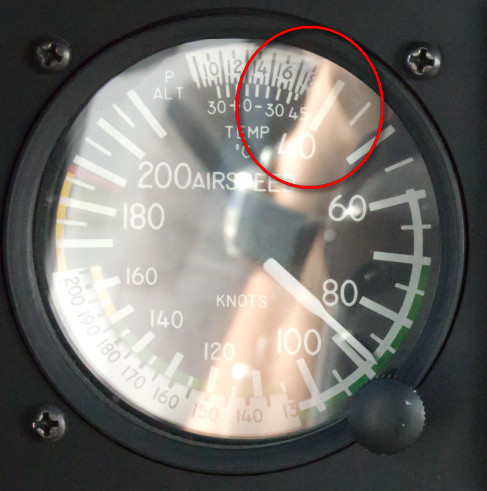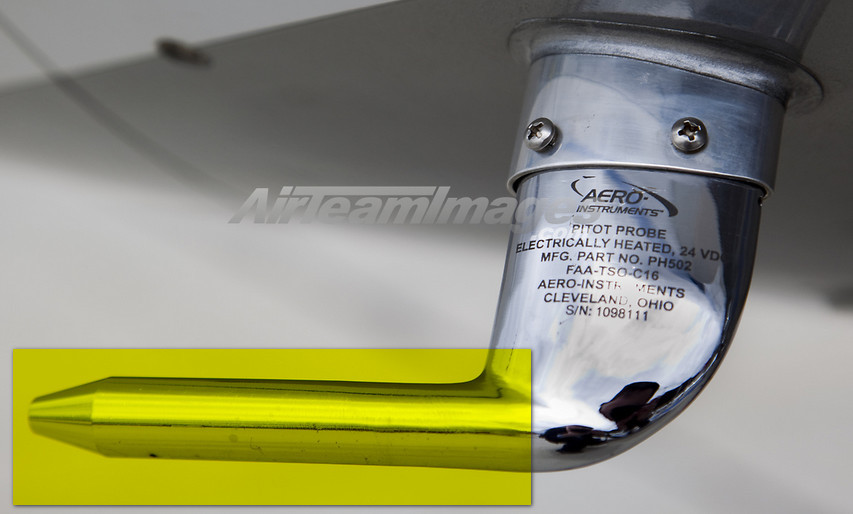The pitot won’t overheat if you are flying, due to the airflow.
On most metal light-GA planes it also won’t overheat on the ground but it won’t do it much good. Most of the planes I did my PPL on had burnt out pitot heaters; the preflight check included a fake pitot heat check where you switched on the pitot heater and touched the stone-cold pitot tube and checked it off as OK 
I switch on the pitot heat when I start the engine. The airflow from the prop should be enough to cool the tube.
This is actually an issue with the AOA indicators (much discussion here in the past e.g. here). It is obvious that one has to have the optional de-iced (heated) version (unless using it purely in VMC e.g. for aerobatics, or “official VFR” in e.g. homebuilts). The one I was looking at had a really powerful heater which would have definitely burnt off the paint on the wing skin if it was left on when on the ground, prop running or not. The only viable installation would have used an “illegal” temperature switch mounted at its base.
I have moved the posts relating to the DFC90 and the GFC700 autopilots, and the DFC90’s “pitot tube frozen => plummet mode” to here
I switch on the pitot heat when I start the engine. The airflow from the prop should be enough to cool the tube.
I think it suffers. If there was any “airflow” you’d see a speed indication…
The Cirrus checklists has the “PITOT HEAT … ON” item in the “Before Takeoff” checklist, and that’s where it belongs IMHO. Of course if you fly in the deep winter, freezing temps, cold rain .. I’d switch it on after engine start too.
JasonC wrote:
might be time to stick some Icex on the boots!
Icex ?
What was that ‘stuff in a can’ that Peter came up with a while back (ex USA) ? Spray-on and ‘inhibits’ ice !!!!
Sounds an ace fix for us non FIKI types. 
Unfortunately that stuff doesn’t work at all. Several threads on it, referenced here
If there was any “airflow” you’d see a speed indication…
Not at the bottom of the scale

In the above, no indication at all below 40kt.
But in any case even a very small draught makes a big difference to the ability of a component to dissipate heat.
OTOH, I don’t think that pitot heat is a problem in the typical metal-skin and standard pitot tube scenario:

The heat is generated only in the highlighted bit. Whereas with say an AOA sensor the whole thing is heated – here is the heated version of the Alpha Systems one

and the whole thing inside the red lines is heated to some massive temperature which would damage the paint on the wing skin if the heater is on while stationary on the ground. 28V at 8A is 224W! I would estimate a delta-T of of the order of 200C!
I think there’s next to ZERO airflow near the probe.
My ASI starts at zero, but I don’t know how precise it can be between 0 and 40 KIAS.
Probably with a metal airplane it’s better.
I am pretty sure the heating elements get damaged if you use it too long on the ground, and it’s really such an important item to have, I rather not damage it. That’s why I will switch it on at the holding point
On the SR22T and PA34 checklists I find the turning on of the pitot heat at the point of turning onto the runway just before departure. I think the PA34 manual states explicitly that the pitot heat can not be on for longer than 3 minutes on the ground. If I land with the SR22T the Garmin Perspective will immediately start blaring at me that the pitot heat is on while on the ground (and the other way around if I did not turn it on while getting close to freezing temps).
However, I can’t remember having the 3 minutes or so limitation with the pitot heat on the Piper Archer 2 and 3, so it then must depend on the type of pitot heat you have installed as well.
A pilot on COPA has investigated this matter at a PITOT TUBE Manufacturing company wher he talked to an engineer about it. That’s what he found out:
MTBF is around 50,000 flight hours! If the pitot heat is accidentally left on in still air, after about 40 minutes the chrome plating on the head will start to discolor. There is no other effect on function, although (the engineer) estimated that the heater element’s life may be reduced by 10,000 hours or so – leaving ‘only’ 40,000 hours of useful life. If the pitot heat is left on long enough to cause the chrome to blister, the underlying metal will fall victim to corrosion, and then all longevity bets are off. At the relatively low speeds we fly, the head gets hot enough to vaporize water/ice on contact.
you don’t need clouds to make ice. as long as the air is moist and the dewpoint spread is small, at or below freezing you can get ice.
@ Peter
Is the Pitot Heat Warning Light in the Annuciator Panel a reliable indication tha the pitot heat doesn’t work? will the current always stop flowing is the heater element is damaged? Or is it thinkable that the light stays out although the heater elements don’t generate any or enough heat?
From the SR22 manual:
Pitot Heat Light
Illumination of the amber PITOT HEAT caution light indicates that the Pitot Heat switch is in the ‘on’ position and the Pitot heater is not receiving electrical current. A current sensor on the Pitot heater power supply wire provides current sensing. The PITOT HEAT warning light operates on 28 VDC supplied through the 2-amp ANNUN / ENGINE INST circuit breaker on the Essential Bus
And
Pitot Heat Switch
The heated Pitot system consists of a heating element in the pitot tube, a rocker switch labeled PITOT HEAT, and associated wiring. The switch and circuit breaker are located on the left side of the switch and control panel. When the pitot heat switch is turned on, the element in the Pitot tube is heated electrically to maintain proper operation in possible icing conditions. Pitot heat should be used only when required. The Pitot heat system operates on 28 VDC supplied through the 7.5-amp PITOT HEAT/COOLING FAN circuit breaker on the Non- Essential Bus
Flyer59 wrote:
Or is it thinkable that the light stays out although the heater elements don’t generate any or enough heat?
Nothing is unthinkable and I have seen incandescent bulbs failing in a way they consumed more current (short between two windings), at least for some time, I would expect that most failures would simply break the heater resistor and thus simply stop consuming current.